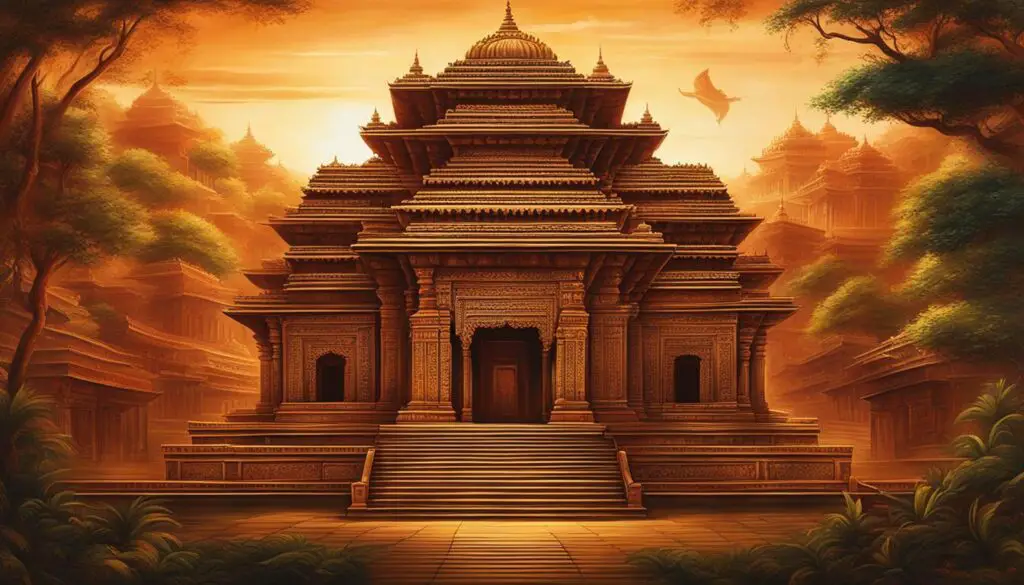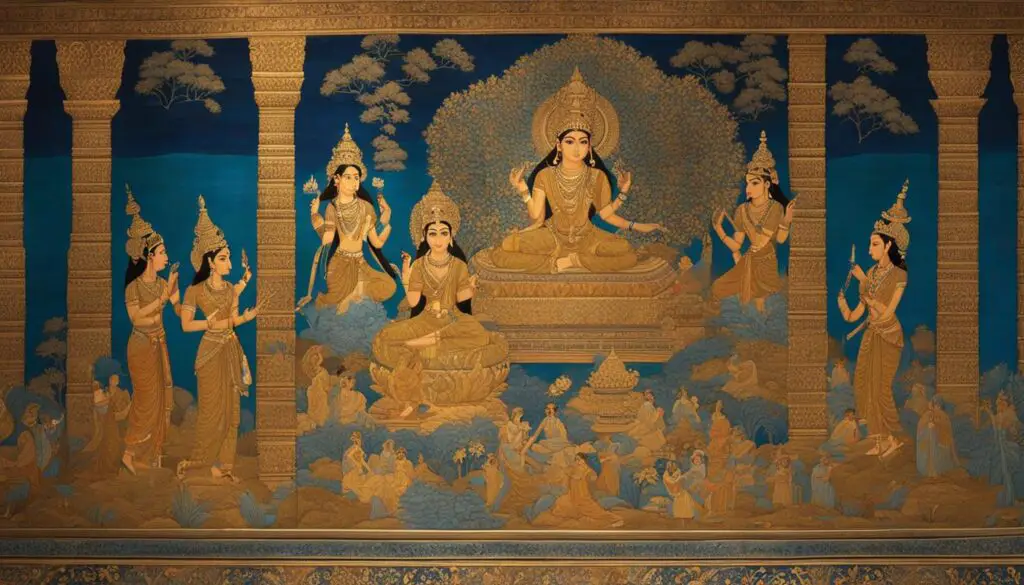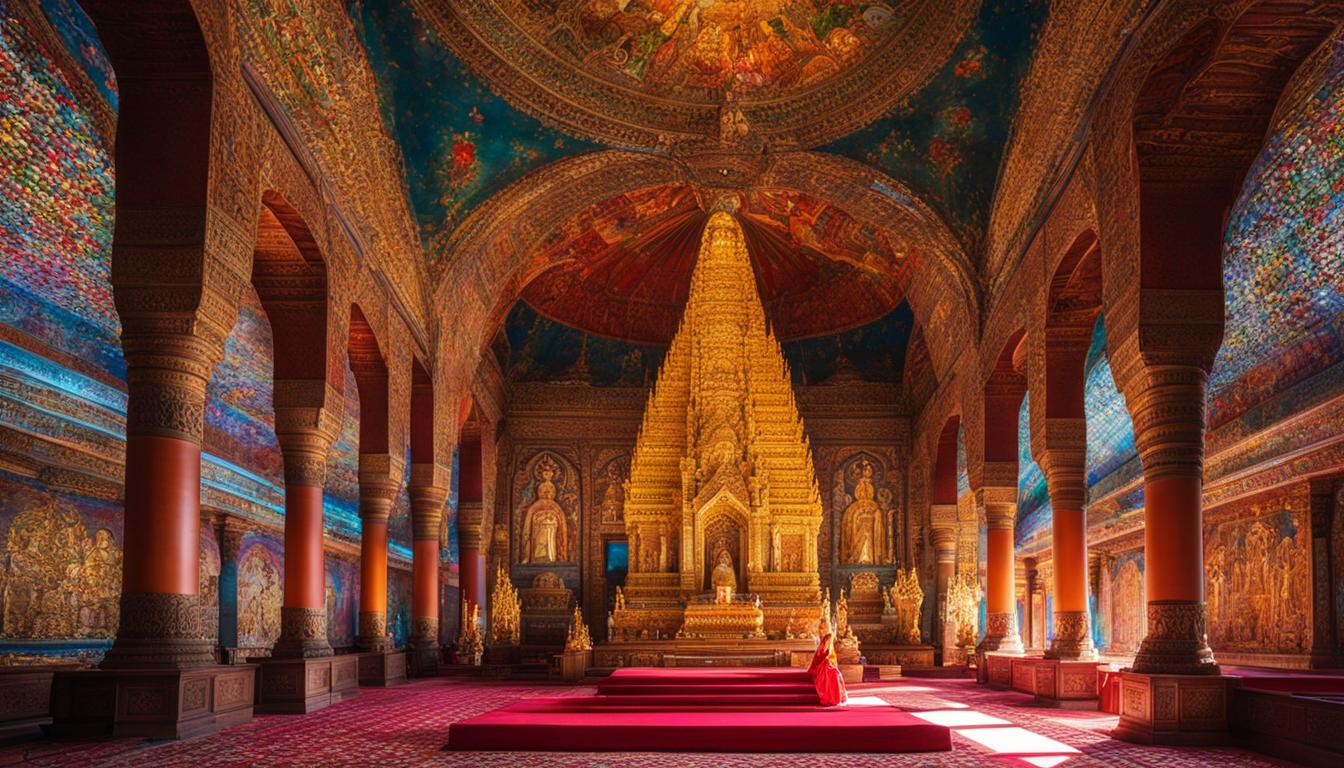Indian folk art is a vibrant and diverse form of artistic expression that encompasses a wide range of traditional and regional art forms. From paintings and pottery to embroidery and puppetry, these art forms are deeply rooted in Indian traditions and serve as a powerful cultural expression.
When we think of Indian folk art, we often envision beautiful paintings depicting intricate details and vibrant colors. Madhubani painting, Warli painting, Pattachitra, Tanjore paintings, and Pichwai paintings are some of the famous Indian folk art paintings that have gained international recognition.
In addition to paintings, pottery, embroidery, and puppetry also play a significant role in Indian folk art. Each of these art forms has its own unique style, method, and symbolism, showcasing the rich cultural heritage of India.
Key Takeaways:
- Indian folk art encompasses various traditional and regional art forms.
- Madhubani painting, Warli painting, Pattachitra, Tanjore paintings, and Pichwai paintings are famous Indian folk art paintings.
- Pottery, embroidery, and puppetry are also significant forms of Indian folk art.
- Each art form has its own unique style, method, and symbolism, showcasing India’s diverse cultural heritage.
- Indian folk art plays a crucial role in preserving and promoting the country’s artistic legacy.
The Symbolism and Tranquility of Temple Paintings
Temple paintings in India hold immense religious, cultural, and artistic significance. They depict the grandeur and symbolism of temples while evoking a sense of tranquility and spirituality. Artists have captured the essence of temples in various styles, showcasing their architectural beauty and divine presence.
These paintings often explore the concept of the bija or seed, symbolizing the potential for divine consciousness and creation. They depict the eternal cycle of creation and the divine energy that permeates all existence. Artists like Iruvan Karunakaran, Surekha Kamath, and Sudha Srivastava have beautifully portrayed temples in their artwork, preserving India’s rich cultural heritage.

The intricate details and symbolic representations in temple paintings invite viewers to immerse themselves in the spiritual atmosphere, offering a visual feast for the senses. The use of vibrant colors and meticulous brushwork brings life to the divine figures, deities, and mythological characters depicted in these artworks.
Temple paintings not only serve as decorative elements in sacred spaces but also convey profound messages and narratives from ancient scriptures. Through their symbolism and storytelling, they connect people with the essence of Indian art, spirituality, and cultural traditions.
“Temple paintings transport us to a world of tranquility, where we can contemplate the divine and reflect on the eternal truths that these artworks convey.”
The tranquility and serenity exuded by temple paintings make them perfect for creating peaceful and meditative environments. Whether displayed in temples, homes, or art galleries, these paintings have the power to evoke a sense of calmness and spiritual awakening in the viewers.
Symbolism in Temple Paintings
The symbolic elements in temple paintings play a crucial role in conveying deeper meanings and stories. Various symbols represent different aspects of spirituality, mythology, and cultural beliefs. Some common symbols found in temple paintings include:
- Lotus: symbolizes purity, beauty, and spiritual awakening
- Peacock: represents divinity, immortality, and protection
- Elephant: signifies strength, wisdom, and prosperity
- Snake: symbolizes divine energy, transformation, and fertility
These symbols, combined with the artistic techniques employed by the painters, create a visual language that transcends words, allowing viewers to connect with the divine and experience a sense of tranquility.
Temple paintings are a testament to the exquisite craftsmanship, cultural richness, and spiritual depth of Indian art. They continue to inspire and captivate art enthusiasts, fostering a deeper appreciation for India’s artistic heritage.
| Symbol | Meaning |
|---|---|
| Lotus | Purity, beauty, spiritual awakening |
| Peacock | Divinity, immortality, protection |
| Elephant | Strength, wisdom, prosperity |
| Snake | Divine energy, transformation, fertility |
The Magnificent Legacy of Temple Murals
Temple murals in India showcase the exquisite details and vibrant colors of ancient civilizations. These awe-inspiring artworks offer a captivating glimpse into India’s rich cultural history and artistic heritage.
One of the most well-known examples of temple murals are the Ajanta paintings. Dating back to the 5th century, these murals adorn the walls of the Ajanta Caves and depict palaces, textiles, and everyday life during that era. They provide valuable insights into the social, religious, and cultural aspects of ancient Indian society.
The Kailash Nath temple in Kanchipuram is another testament to the legacy of mural paintings. This 8th-century temple is adorned with intricate murals showcasing scenes from Hindu mythology, illustrating the stories of gods and goddesses.
The Sittanavasal caves in Tamil Nadu also boast remarkable murals. Dating back to the 7th century, these vibrant paintings depict Jains saints, their lives, and their journey towards enlightenment. They are a testament to the rich cultural diversity and religious harmony that existed in ancient India.
One cannot discuss temple murals without mentioning the Brihadeeswarar Temple at Thanjavur. Built in the 11th century by the Chola dynasty, this UNESCO World Heritage Site is famous for its magnificent murals, reflecting the grandeur and artistic finesse of the era.
In the Ladakh region, the Alchi Monastery is adorned with beautiful murals that blend Indian and Tibetan artistic styles. These murals offer a glimpse into the cosmopolitan culture that thrived in the region, showcasing the cultural exchange between India and Tibet.
The Lepakshi temple in Andhra Pradesh is another treasure trove of mural paintings. Dating back to the 16th century, these artistic masterpieces showcase scenes from the great Indian epics like the Ramayana and Mahabharata, as well as mythological figures and celestial beings.
These temple murals not only mesmerize with their artistic brilliance but also provide valuable insights into the politics, lifestyles, and customs of bygone eras. They are a testament to India’s rich cultural heritage and the legacy of artistic expression that continues to inspire and captivate audiences today.

Conclusion
Temple art in India is a testament to the country’s rich heritage and cultural splendor. From the vibrant folk art paintings to the intricately crafted murals, each art form tells a captivating story and plays a vital role in preserving India’s artistic legacy.
The artistic expression found in temple paintings goes beyond mere aesthetics. It captures the essence of spirituality, cultural symbolism, and the divine presence in a unique and mesmerizing manner. These paintings reflect India’s ancient traditions and celebrate the country’s aesthetic heritage.
Furthermore, temple art continues to inspire and captivate audiences, bridging the gap between the past and present. It serves as a medium through which India’s cultural heritage is cherished and preserved for generations to come. The intricate brushstrokes, vivid colors, and exquisite details of temple art transport viewers to a world where they can experience the beauty and spirituality of Indian culture firsthand.
Through temple art, India’s artistic traditions remain alive, allowing us to appreciate the remarkable talent and creativity of the artists who have gone before us. These art forms are a reflection of India’s rich cultural tapestry, and their preservation ensures that future generations can continue to marvel at the cultural splendor that has defined the nation for centuries. Temple art truly embodies the spirit of India, connecting us to our roots, and reminding us of the profound impact that art can have on our lives.
FAQ
What is Indian folk art?
Indian folk art is a diverse and vibrant form of artistic expression that encompasses various traditional and regional art forms such as paintings, pottery, embroidery, weaving, mask-making, puppetry, and more.
What are some famous Indian folk art paintings?
Some famous Indian folk art paintings include Madhubani painting, Warli painting, Pattachitra, Tanjore paintings, and Pichwai paintings.
What other forms of art are significant in Indian folk art?
Pottery, embroidery, and puppetry are also significant forms of Indian folk art.
What do temple paintings in India depict?
Temple paintings in India depict the grandeur and symbolism of temples while evoking a sense of tranquility and spirituality.
What do temple paintings explore?
Temple paintings often explore the concept of the bija or seed, symbolizing the potential for divine consciousness and creation.
Who are some artists known for depicting temples in their artwork?
Artists like Iruvan Karunakaran, Surekha Kamath, and Sudha Srivastava have beautifully portrayed temples in their artwork, preserving India’s rich cultural heritage.
Are there any famous temple murals in India?
Yes, there are many famous temple murals in India, such as the Ajanta paintings, the Kailash Nath temple in Kanchipuram, the Sittanavasal caves, and the Brihadeeswarar Temple at Thanjavur.
What insights do temple murals provide?
Temple murals provide valuable insights into the politics, lifestyles, and customs of bygone eras.

